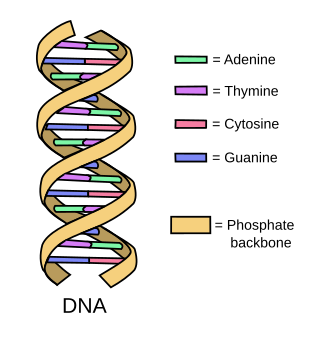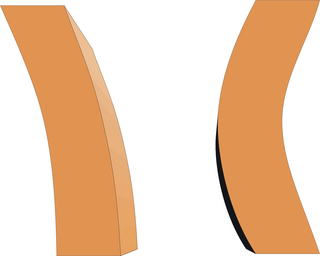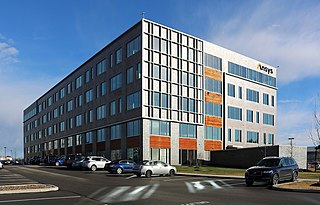Related Research Articles

Structural engineering is a sub-discipline of civil engineering in which structural engineers are trained to design the 'bones and joints' that create the form and shape of human-made structures. Structural engineers also must understand and calculate the stability, strength, rigidity and earthquake-susceptibility of built structures for buildings and nonbuilding structures. The structural designs are integrated with those of other designers such as architects and building services engineer and often supervise the construction of projects by contractors on site. They can also be involved in the design of machinery, medical equipment, and vehicles where structural integrity affects functioning and safety. See glossary of structural engineering.

A structure is an arrangement and organization of interrelated elements in a material object or system, or the object or system so organized. Material structures include man-made objects such as buildings and machines and natural objects such as biological organisms, minerals and chemicals. Abstract structures include data structures in computer science and musical form. Types of structure include a hierarchy, a network featuring many-to-many links, or a lattice featuring connections between components that are neighbors in space.
Software design is the process by which an agent creates a specification of a software artifact intended to accomplish goals, using a set of primitive components and subject to constraints. The term is sometimes used broadly to refer to "all the activity involved in conceptualizing, framing, implementing, commissioning, and ultimately modifying" the software, or more specifically "the activity following requirements specification and before programming, as ... [in] a stylized software engineering process."
A Bachelor of Engineering or Bachelor of Science in Engineering (BSE) is an undergraduate academic degree awarded to a college graduate majoring in an engineering discipline at a higher education institution.

LS-DYNA is an advanced general-purpose multiphysics simulation software package developed by the former Livermore Software Technology Corporation (LSTC), which was acquired by Ansys in 2019. While the package continues to contain more and more possibilities for the calculation of many complex, real world problems, its origins and core-competency lie in highly nonlinear transient dynamic finite element analysis (FEA) using explicit time integration. LS-DYNA is used by the automobile, aerospace, construction and civil engineering, military, manufacturing, and bioengineering industries.
Hardy Cross (1885–1959) was an American structural engineer and the developer of the moment distribution method for structural analysis of statically indeterminate structures. The method was in general use from c. 1935 until c. 1960 when it was gradually superseded by other methods.
In the context of software engineering, software quality refers to two related but distinct notions:

Seismic analysis is a subset of structural analysis and is the calculation of the response of a building structure to earthquakes. It is part of the process of structural design, earthquake engineering or structural assessment and retrofit in regions where earthquakes are prevalent.

Ansys, Inc. is an American multinational company with its headquarters based in Canonsburg, Pennsylvania. It develops and markets CAE/multiphysics engineering simulation software for product design, testing and operation and offers its products and services to customers worldwide.

NEi Nastran was an engineering analysis and simulation software product of NEi Software. Based on NASA's Structural Analysis program NASTRAN, the software is a finite element analysis (FEA) solver used to generate solutions for linear and nonlinear stress, dynamics, and heat transfer characteristics of structures and mechanical components. NEi Nastran software is used with all major industry pre- and post-processors, including Femap, a product of Siemens PLM Software, and the in-house brands NEi Nastran in-CAD, NEi Fusion, and NEi Works for SolidWorks. This software was acquired by Autodesk in May 2014.
Tekla is a software product family that consists of programs for analysis and design, detailing and project communication. Tekla software is produced by Trimble, the publicly listed US-based technology company.
LUSAS is a UK-based developer and supplier of Finite Element Analysis (FEA) application software products that bear the same name.
The Bridge Software Institute is headquartered at the University of Florida (UF) in Gainesville, Florida. It was established in January 2000 to oversee the development of bridge related software products at UF. Today, Bridge Software Institute products are used by engineers nationwide, both in state Departments of Transportation and leading private consulting firms. Bridge Software Institute software is also used for the analysis of bridges in various countries by engineers around the world.
Extreme Loading for Structures (ELS) is commercial structural-analysis software based on the applied element method (AEM) for the automatic tracking and propagation of cracks, separation of elements, element collision, and collapse of structures under extreme loads. AEM combines features of Finite element method and Discrete element method simulation with its own solver capabilities for the generation of PC-based structural analysis.
ADINA is a commercial engineering simulation software program that is developed and distributed worldwide by ADINA R & D, Inc. The company was founded in 1986 by Dr. Klaus-Jürgen Bathe, and is headquartered in Watertown, Massachusetts, United States. On April 7, 2022, Bentley Systems acquired ADINA R&D, Inc.
Computers and Structures, Inc. (CSI) is a structural and earthquake engineering software company founded in 1975 and based in Walnut Creek, California, with additional office location in New York. The structural analysis and design software CSI produce include SAP2000, CSiBridge, ETABS, SAFE, PERFORM-3D, and CSiCOL.
Sesam is a software suite for structural and hydrodynamic analysis of ships and offshore structures. It is based on the displacement formulation of the Finite Element Method.

Ashraf Habibullah is a Pakistani-American structural engineer and software developer best known as the founder, president, and CEO of Computers and Structures, Inc., a structural and earthquake engineering software company based in Berkeley, California. Upon founding the privately held company in 1975, Ashraf co-created the first structural-engineering software available to the personal computer, and has since created a suite of products, and developed their capabilities. Notably, ETABS, a multi-story building analysis and design software, received recognition as one of the Applied Technology Council and Engineering News-Record Top Seismic Products of the 20th Century. Today, CSI is recognized globally as the pioneer in the development of software for structural and earthquake engineering. CSI's software is used by thousands of engineering firms and is the choice of sophisticated design professionals in over 160 countries. Ashraf has a deep personal interest in the study of human psychology and human behavior and how they can be leveraged to help people from all walks of life reach their maximum potential.
MSC Marc is a nonlinear finite elements analysis software used to simulate behavior of complex materials and interaction under large deformations and strains. It can also simulate multi-physics scenarios across structural, thermal, piezoelectric, electrostatic, magnetostatic, and electromagnetic behaviors. It uses automatic two-dimensional and three-dimensional remeshing to analyze structures undergoing large distortions, and crack propagation.